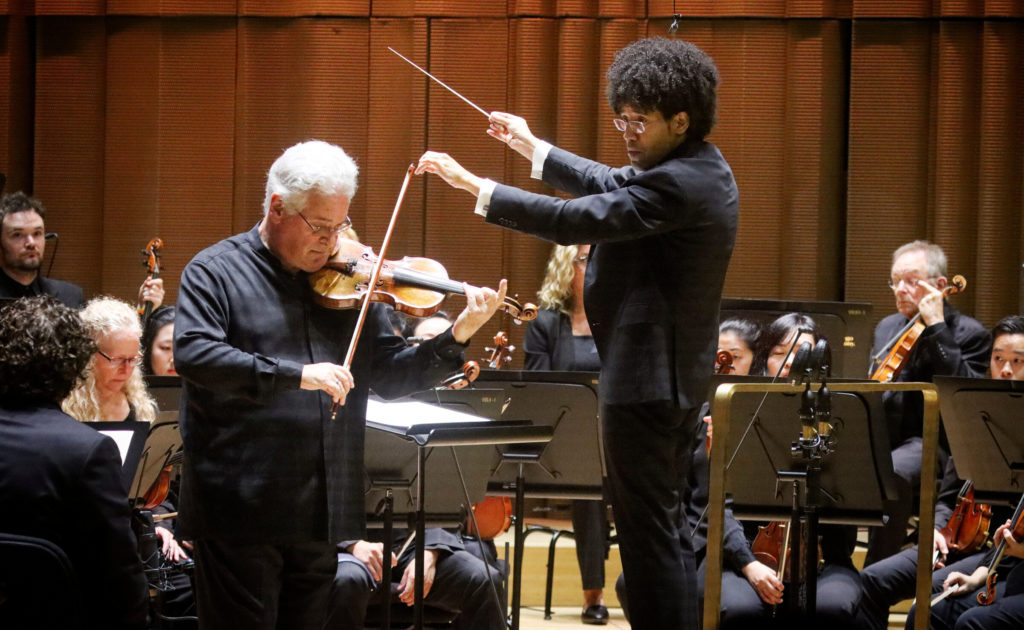Rafael Payare Gives Schoenberg’s ‘Pelléas und Mélisande’ a Welcome Revival in the Sonically Renewed Jacobs Music Center
Mention the names Pelléas and Mélisande to opera aficionados, and they will immediately think of Claude Debussy’s nonpareil grand opera based on and named after Maurice Maeterlinck’s play Pelléas et Mélisande. And regular symphony patrons have probably encountered Suites by Gabriel Fauré or Jean Sibelius written as incidental music for the Maeterlinck play.
But rare is the music aficionado who has experienced Arnold Schoenberg’s 1905 symphonic poem Pelléas und Méllisande, Op. 5. San Diego Symphony Music Director Rafael Payere and the orchestra brought Schoenberg’s mysterious Op. 5 to the Jacobs Music Center Saturday and Sunday. A sumptuous symphonic spectacle, Schoenberg’s Pelléas und Mélisande requires a large orchestra with a massive brass section—18 players—and more clarinets on stage than is legal in certain provinces.
It was the master of the late Romantic tone poem, Richard Strauss, who suggested to the 28-year-old Schoenberg in 1902 that he compose the Maeterlinck play as an opera, unaware that Debussy’s Pelléas et Mélisande was about to open at the Paris Opera. Schoenberg rejected Strauss’s suggestion, however, but instead followed the example of the composer of Don Juan, Ein Heldenleben, and Don Quixote by creating the tragic love story of Pelléas and Mélisande as a purely orchestral work.
The particular challenge of presenting Schoenberg’s work is that it recounts the drama of Maeterlicnk’s ill-fated lovers in one continuous movement that lasts from 40 to 45 minutes. Payere solved this by having two actors read a summary of the play’s dramatic action before the music commenced, and, as the work progressed, captions were flashed on the digital screen above the stage that indicated what segment of the plot the music was either illustrating or reacting to.
Considering the austerity of Schoenberg’s later 12-tone compositions, his Pelléas und Mélisande provides a torrent of pulsing dramatic episodes, exploiting a late Romantic harmonic palette laced with chromatic inflections that are surprisingly free of even a hint of Wagnerian ooze.
Payare’s masterful direction brought Schoenberg’s depictions of the play’s three characters into sharp focus: a chromatic minor mode leitmotif for the elusive Mélisande; bold, assertive arcs for the dashing Prince Golaud, who rescues Mélisande and marries her, and bright trumpet calls for his aspiring young brother Pelléas, who captures the affection of his brother’s wife. And no Romantic drama would be complete without a fate motif based on the dangerous leap of an augmented seventh interval.
As a vivid scene painter, in this work Schoenberg excels. Principal Flute Rose Lombardo offered intoxicating solos at the first meeting of the illicit lovers in a park; Principal Bass Jeremy Kurtz-Harris and his section crafted the chilling, ominous rising themes depicting Golaud’s jealousy, while shimmering violins and violas expressed the ardor of the young lovers. Principal Timpani Ryan J. DiLisi’s sonic eruption when Golaud killed Pelléas was followed by Andrea Overture’s haunting English Horn elegy that expressed Mélisande’s grief over the loss of Pélleas.
Payare adroitly shaped Schoenberg’s ample dramatic climaxes, especially the brilliant fortes, rendered more exciting in the hall’s newly revised acoustical environment. He took his time, however, developing Schoenberg’s symphonic tableaux. An online performance of Pelléas und Mélisande conducted by Pierre Boulez and a Swiss orchestra came in at 41 minutes, a suggested time mirrored in the Symphony’s program notes in the Performances program book. By my watch, Payere gave this Schoenberg a luxurious 46 minutes at Saturday’s concert. But I believe it was time well spent in a rich but strangely overlooked score.
Guest violinist Pinchas Zuckerman opened this concert with an uncommonly elegant account of Beethoven’s familiar Violin Concerto in D Major, a last-minute substitute for Sergey Khachatryan, who was scheduled to play Brahms’ D Major Violin Concerto. Zuckerman won the immediate approval of his audience with the polished finesse of his understated approach and the ingratiating silvery edge of his refined sonority. I was impressed with his more vigorous account of the Rondo, for which he discovered an effervescence missing from the opening movement and which Payere matched with welcome orchestral ebullience. And Zuckerman’s athletic final cadenza capped the concerto with elation that brought the audience to its feet.
This concert was presented by the San Diego Symphony on October 12 & 13, 2024, at the Jacobs Music Center in downtown San Diego. The October 12 performance was attended for this review.

Ken Herman, a classically trained pianist and organist, has covered music for the San Diego Union, the Los Angeles Times’ San Diego Edition, and for sandiego.com. He has won numerous awards, including first place for Live Performance and Opera Reviews in the 2017, the 2018, and the 2019 Excellence in Journalism Awards competition held by the San Diego Press Club. A Chicago native, he came to San Diego to pursue a graduate degree and stayed.Read more…

